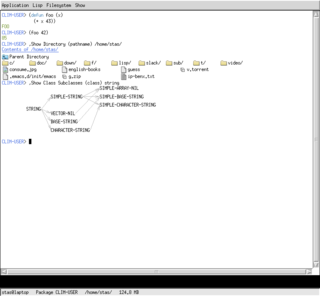Related Research Articles
Common Lisp (CL) is a dialect of the Lisp programming language, published in ANSI standard document ANSI INCITS 226-1994 (S20018). The Common Lisp HyperSpec, a hyperlinked HTML version, has been derived from the ANSI Common Lisp standard.

Lisp is a family of programming languages with a long history and a distinctive, fully parenthesized prefix notation. Originally specified in 1958, Lisp is the second-oldest high-level programming language. Only Fortran is older, by one year. Lisp has changed since its early days, and many dialects have existed over its history. Today, the best-known general-purpose Lisp dialects are Racket, Common Lisp, Scheme, and Clojure.
Prototype-based programming is a style of object-oriented programming in which behaviour reuse is performed via a process of reusing existing objects that serve as prototypes. This model can also be known as prototypal, prototype-oriented,classless, or instance-based programming.
An object-oriented operating system is an operating system that is designed, structured, and operated using object-oriented programming principles.
In computer science, reflective programming or reflection is the ability of a process to examine, introspect, and modify its own structure and behavior.
In computer science, a metaobject is an object that manipulates, creates, describes, or implements objects. The object that the metaobject pertains to is called the base object. Some information that a metaobject might define includes the base object's type, interface, class, methods, attributes, parse tree, etc. Metaobjects are examples of the computer science concept of reflection, where a system has access to its own internal structure. Reflection enables a system to essentially rewrite itself on the fly, to alter its own implementation as it executes.
Flavors, an early object-oriented extension to Lisp developed by Howard Cannon at the MIT Artificial Intelligence Laboratory for the Lisp machine and its programming language Lisp Machine Lisp, was the first programming language to include mixins. Symbolics used it for its Lisp machines, and eventually developed it into New Flavors; both the original and new Flavors were message passing OO models. It was hugely influential in the development of the Common Lisp Object System (CLOS).
The actor model in computer science is a mathematical model of concurrent computation that treats actor as the universal primitive of concurrent computation. In response to a message it receives, an actor can: make local decisions, create more actors, send more messages, and determine how to respond to the next message received. Actors may modify their own private state, but can only affect each other indirectly through messaging.
In computer science, Actor model implementation concerns implementation issues for the Actor model.
In computer science, future, promise, delay, and deferred refer to constructs used for synchronizing program execution in some concurrent programming languages. They describe an object that acts as a proxy for a result that is initially unknown, usually because the computation of its value is not yet complete.
In computer science, the Actor model, first published in 1973, is a mathematical model of concurrent computation. This article reports on the middle history of the Actor model in which major themes were initial implementations, initial applications, and development of the first proof theory and denotational model. It is the follow on article to Actor model early history which reports on the early history of the Actor model which concerned the basic development of the concepts. The article Actor model later history reports on developments after the ones reported in this article.
In computer science, the Actor model, first published in 1973, is a mathematical model of concurrent computation. This article reports on the later history of the Actor model in which major themes were investigation of the basic power of the model, study of issues of compositionality, development of architectures, and application to Open systems. It is the follow on article to Actor model middle history which reports on the initial implementations, initial applications, and development of the first proof theory and denotational model.

The Common Lisp Interface Manager (CLIM) is a Common Lisp-based programming interface for creating user interfaces, i.e., graphical user interfaces (GUIs). It provides an application programming interface (API) to user interface facilities for the programming language Lisp. It is a fully object-oriented programming user interface management system, using the Common Lisp Object System (CLOS) and is based on the mechanism of stream input and output. There are also facilities for output device independence. It is descended from the GUI system Dynamic Windows of Symbolics' Lisp machines between 1988 and 1993.
... you can check out Common Lisp Interface Manager (CLIM). A descendant of the Symbolics Lisp machines GUI framework, CLIM is powerful but complex. Although many commercial Common Lisp implementations actually support it, it doesn't seem to have seen a lot of use. But in the past couple years, an open-source implementation of CLIM, McCLIM – now hosted at Common-Lisp.net – has been picking up steam lately, so we may be on the verge of a CLIM renaissance. – From Practical Common Lisp
CommonLoops is an early programming language which extended Common Lisp to include Object-oriented programming functionality and is a dynamic object system which differs from the OOP facilities found in static languages such as C++ or Java. Like New Flavors, CommonLoops supported multiple inheritance, generic functions and method combination. CommonLoops also supported multi-methods and made use of metaobjects. CommonLoops and New Flavors were the primary ancestors of CLOS. CommonLoops was supported by a portable implementation known as Portable CommonLoops (PCL) which ran on all Common Lisp implementations of the day.
Daniel L. Weinreb was an American computer scientist and programmer, with significant work in the environment of the programming language Lisp.

Akinori Yonezawa is a Japanese computer scientist specializing in object-oriented programming, distributed computing and information security. Being a graduate of the University of Tokyo, Yonezawa has a Ph.D in computer science from MIT in the Actor group at the MIT AI Lab. He currently teaches at the University of Tokyo. He is the designer of ABCL/R, a reflective subset of the first concurrent object-oriented programming language ABCL/1.

Carl Eddie Hewitt is an American computer scientist who designed the Planner programming language for automated planning and the actor model of concurrent computation, which have been influential in the development of logic, functional and object-oriented programming. Planner was the first programming language based on procedural plans invoked using pattern-directed invocation from assertions and goals. The actor model influenced the development of the Scheme programming language, the π-calculus, and served as an inspiration for several other programming languages.
The composition filters model denotes a modular extension to the conventional object model. It provides a solution for a wide range of problems in the construction of large and complex applications. Most notably, one implementation of composition filters provides an abstraction layer for message-passing systems.